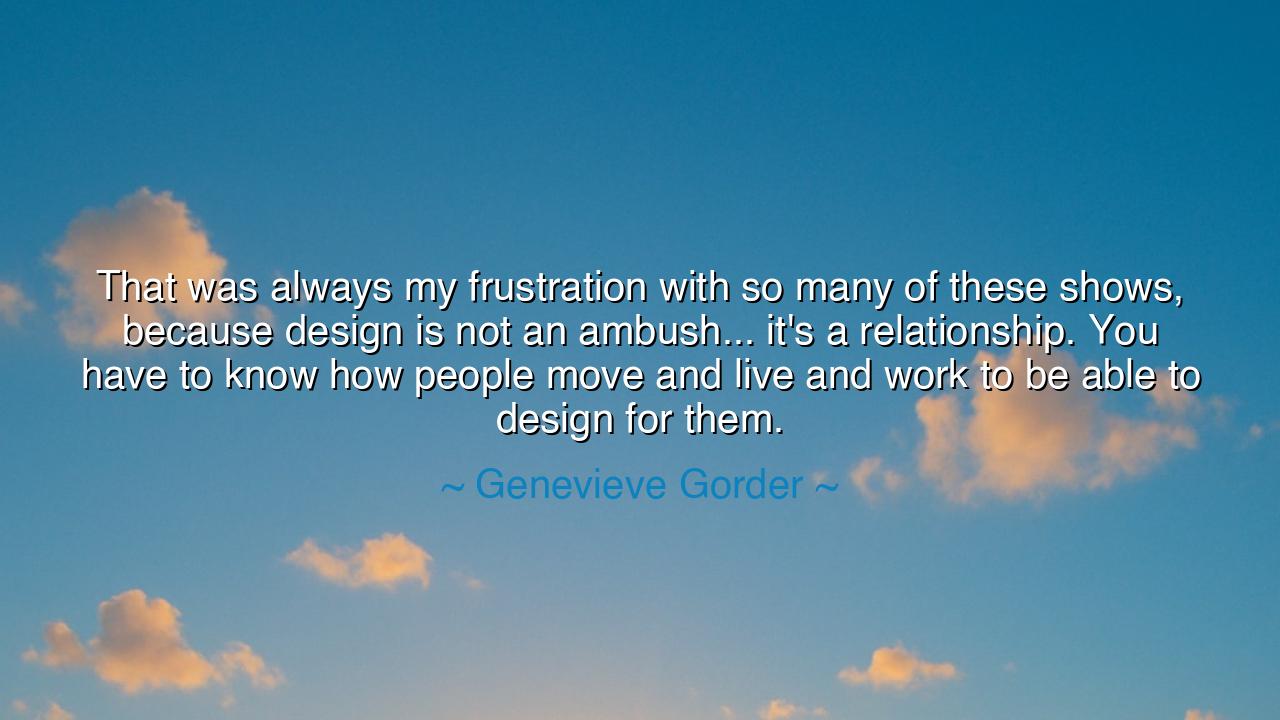
That was always my frustration with so many of these shows
That was always my frustration with so many of these shows, because design is not an ambush... it's a relationship. You have to know how people move and live and work to be able to design for them.






In the heartfelt and discerning words of Genevieve Gorder, artist and designer of spaces that breathe human spirit, we hear not merely a critique of television but a timeless principle: “That was always my frustration with so many of these shows, because design is not an ambush... it's a relationship. You have to know how people move and live and work to be able to design for them.” Her statement pierces beyond the surface of entertainment and into the essence of creation itself. For she reminds us that true design — like love, friendship, or teaching — is not an act of surprise or imposition, but of deep understanding. To create for another without knowing them is not art, but arrogance; to design with empathy is to touch the divine.
To call design a relationship is to recognize that it lives at the intersection of soul and structure. The architect of beauty must first become a listener of lives. Every home, every space, every crafted object is a dialogue between maker and dweller — between what is seen and what is felt. Gorder’s words recall an ancient truth: that the role of the artist is not to impose vision, but to reveal harmony between form and function, between the human heart and the physical world it inhabits. She laments a culture that treats creation as spectacle — the “ambush” of surprise makeovers — when true design demands intimacy, patience, and trust.
The origin of this wisdom springs from Gorder’s years in design, where she learned that beauty cannot be manufactured without meaning. Her work on home transformation shows introduced her to families whose homes were not just structures, but stories — places that carried grief, memory, and hope. Over time, she came to see that the most beautiful designs were not those that impressed strangers but those that understood their inhabitants. A room filled with light means nothing if it does not comfort the one who dwells there. Thus she came to speak this truth: that design must begin not with aesthetics, but with empathy; not with decoration, but with devotion.
This insight calls to mind the ancient builders of sacred spaces — those who shaped temples, cathedrals, and shrines not for fame, but for communion. The artisans of Chartres Cathedral did not build to dazzle kings; they built to lift souls toward heaven. Every arch, every window of colored glass was designed with the pilgrim in mind — the weary traveler seeking light. The builders knew that to design for others was to serve them, to honor their journey, and to make sacred the ground they walked upon. Like Gorder, they understood that design is not an ambush, but a covenant — a promise between creator and receiver, written in stone and spirit.
To know how people move and live and work is to see design not as a product, but as a reflection of life itself. The wise designer studies the rhythm of the home — where sunlight falls, where laughter gathers, where silence is needed. They shape not just rooms, but rituals. They do not ask, “What will look impressive?” but, “What will bring peace?” Gorder’s words echo the wisdom of the ancients who taught that form must follow soul. Just as a garment must fit the wearer’s body, so must a space fit the pulse of the lives within it. The designer who ignores this truth creates shells; the one who honors it creates sanctuaries.
And yet, Gorder’s frustration carries a deeper lesson beyond the realm of design. For in truth, all creation — whether of homes, relationships, or societies — is a relationship, not an ambush. You cannot build what you do not understand. The leader who governs without knowing his people builds tyranny; the teacher who instructs without knowing her students builds ignorance; the friend who helps without listening builds distance. In every act of creation, from art to service, we are called to first see and know the other — to listen before shaping, to understand before acting.
Let this be the lesson for those who seek to create meaning in their lives: Approach all creation as relationship. Before you design a space, design yourself to listen. Before you build, learn the hearts of those you build for. Walk their halls, watch their light, hear their stories. Do not rush to impose beauty; instead, invite it to emerge through understanding. For the truest beauty is never forced — it is revealed, patiently, like dawn unfolding over the world.
And so, my children, remember the wisdom of Genevieve Gorder: that design is not an ambush but a relationship, and that every act of creation must begin in love. Whether you craft a home, a work of art, or a life itself, do not seek to astonish — seek to understand. For the beauty that endures is born not of surprise, but of connection. To know another deeply and to shape their world with care — that is the highest form of design, and the purest expression of the human spirit.






AAdministratorAdministrator
Welcome, honored guests. Please leave a comment, we will respond soon